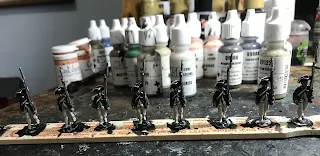Sometimes you paint certain regiments for historical reasons. They fit a historical order of battle or were for a particular battle. But no, not this time. I painted this regiment only because I really like the uniform. Back when I first found a copy of Charles Lefferts Uniforms of the American Revolution his watercolor of the 1st Pennsylvania Battalion 1776 jumped out.
Only later did I find out he made a error. While he thought the uniform was a brown coat faced buff, it most certainly was brown faced green. A very unusual combination but one that is very attractive. So I just had to paint this regiment.
The 1st Pennsylvania Battalion raised in November 1775 and commanded by Colonel John Bull. In 1776 Colonel John Philip Dr Haas assumed command. Under this officer the battalion saw service with the main army under Washington including fighting 1st Trenton and Princeton. On October 25, 1776 the regiment was redesigned the 2nd Pennsylvania Regiment.
The figures are all Old Glory miniatures, second edition. These are a great improvement in the original figures. The regimental colors were photocopied off the internet.





































